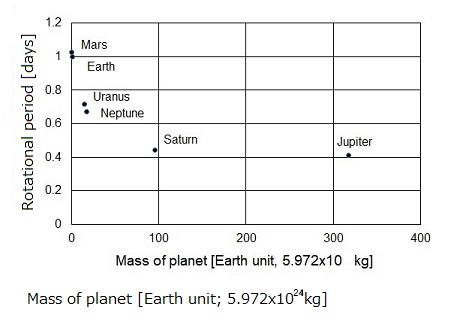3.3 Earth's orbital period and Moon orbital period
If a interstellar medium has the orbiting angular momentum corresponding
to the gravitational potential of its position, it orbits without being
taken up by the gravutational center. The orbital period of he planet is
determined by law of planetary motion that maintains equilibrium in the
gravitational field. Universal gravitational force (FG) between the Sun (MSun) and the Earth (mEarth>) is given in Eq.5.
(FG)=(G・MSun・mEarth)/(RSun-Earth)2 (5)
On the other hand, the centrifugal force of the Earth (Fcentrifugal force) that revolves at velocity (v) is given by Eq.5.
(Fcentrifugal force)= mEarth・(v)2/(RSun-Earth (6)
Assuming Eq.5 = Eq.6, the velocity (vEarth) is given by v = 2.989x104m/s, and the period (T Earth) gives it in Eq.7.
TEarth=2π・RSun-Earth /vEarth =363 days (7)
The orbital period of the Moon is the relationship between the mass of the Earth (MEarth) and the mass of the Moon (mMoon) in Eq.8.
TMoon=2π・REart-Moonh /vMoon =27.4 days (8)
If the Moon's orbit is short and close to the Earth, the orbital speed will be faster.
3.4 Relationship between increase in the mass of a planet and increase of rotation speed of the planet
If the interstellar medium approaches toward the center of gravity, the
gravitational potential increases, and the equilibrium kinetic energy increases.
So the rotational speed becomes faster. When the interstellar medium approaches
toward the center of gravity, the gravitational potential increases, the
equilibrium kinetic energy increases, and the rotational speed becomes
faster. The growth of celestial bodies accompanies with addition of the
rotational momentum of falling matter, the rotation period of the central
body is shortened by fall down of interstellar mediums.
. 
Fig. 7. Period of the rotational motion of planet is nversely proportion
to mass of planet
As shown in Fig. 7, the planets of the solar system have a shorter rotation
period in inverse proportion to the mass of the planets, except for Mercury
and Venus, which rotate very slowly. This indicates that the planet grew
by taking in material orbiting around it. The rotation period of the Sun
is 25.38 days, and the slow rotation speed of the Sun is also effective
in canceling the rotation of the Sun, as described in section 3.3.
3.5 Satellite is formed in geostationary orbit
Many of the satellites of the solar system revolve around facing to the same surface of the main stars.
This is evidence that the satellite was born and grew due to the gravity of the host planet.
When the gravity of the host planet acts, it will be shifted the gravitational center of the satellite by the gravitational force towards the planet.
When the center of gravity of the satellite is shifted to the main planet, the orbit and rotation of the satellite coincide.
Moon's revolution period and of its rotation is the same 27.4 days. The tidal effect is generated by the action of universal gravitational force between faster rotating Earth and slow orbiting of Moon.
Since the Moon's revolution is accelerated by the rotation of the Earth by the gravitational force, the Moon moves away from the Earth. Currently, the distance from the Earth to the Moon is about 380,000 km, and the Moon is about 3.8cm away in one year.
Assuming the same recession velocity in past eras, the distance between the Earth and the Moon (3.8x108) m divided by 3.8x10-2 m equals 1010. It took 10 billion years to get to today's distance. However, when the
Moon is close to the Earth, the tidal effect of the Moon on the Earth is
large. According to the calculation described in Sec.3.7 , the Moon was
born and formed near the Earth's geostationary orbit. (last modified March/6
2023)
index -3.2-